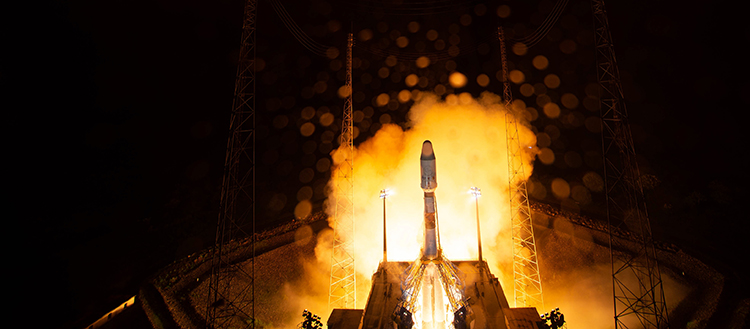One-year launch anniversary of CHEOPS
In its first year in orbit, the CHEOPS space telescope has already revealed details of one of the most extreme exoplanets and showed its maneuverability by evading space debris.

On 18 December 2019, CHEOPS lifts off from Europe's Spaceport in Kourou, French Guiana. (© ESA - S. Corvaja)
Since its launch last year from the European Space Agency (ESA)’s spaceport in Kourou, French Guiana, on December 18 the CHEOPS telescope in Earth’s orbit has demonstrated its functionality and precision beyond expectations. That it would ever to get to that point, was never a certainty, as it was a pioneering project in different aspects. CHEOPS is a joint mission by the European Space Agency (ESA) and Switzerland, under the aegis of the University of Bern in collaboration with the University of Geneva.
From 26 project proposals, CHEOPS was selected as ESA’s so-called first small ‘S-class mission’ back in 2012. The conditions of such a mission were that it had to be realized within a few years and would not cost ESA more than 50 million euro. It is the first Swiss-led mission of ESA, and as such, Switzerland was the primary financial contributor after ESA. Furthermore, CHEOPS is the first ESA mission dedicated to characterizing known exoplanets.
Exoplanets, i.e. planets outside the Solar system, were first found in 1995 by two Swiss astronomers, Michel Mayor and Didier Queloz from the University of Geneva, who were last year awarded the Nobel Prize for this discovery. Since then, over 4000 such planets were found, and CHEOPS was proposed to determine the composition of the most interesting specimens. This ambitious goal required a dedicated collaboration of a consortium of more than a hundred scientists and engineers from eleven European countries, who were involved in constructing CHEOPS under the leadership of the University of Bern and ESA over five years.
“We think that we meet the requirements to deliver ultra-precise measurements to the scientists. Otherwise we would not be flying", said Christopher Broeg, project manager for the CHEOPS mission from the University of Bern, upon completion of construction. And meet them, they did. In close collaboration with the University of Geneva, where the Science Operations Center of CHEOPS is located, the instrument has already collected plenty of data. Despite the extraordinary circumstances the Covid-19 pandemic has created, CHEOPS scientists have recently carried out a detailed study of an extreme exoplanet based on some of this data. “And the next papers are already in preparation”, as Willy Benz, Professor of astrophysics at the University of Bern and head of the CHEOPS consortium, reports.
In the beginning of October 2020, the CHEOPS space telescope had to make an evasive maneuver due to a piece of space debris. "In the event of a collision, this could have meant the destruction of the CHEOPS space telescope", as Willy Benz points out.
Strong collaboration between universities and industrial partners
“This mission really stands out in Swiss space activity”, as Renato Krpoun, head of the Swiss Space Office, puts it, “and reflects on the strong collaboration with industrial partners”. Christian Leumann, rector of the University of Bern, points out that the CHEOPS mission "underlines our presence in space research and gives Switzerland international visibility." Yves Flückiger, rector of the University of Geneva, adds: “I am more than content with the close collaboration between our universities as well as with the industrial partners.”
Exciting scientific year to come
The mission presents an excellent opportunity for scientists world-wide, explains Kate Isaak, ESA Project Scientist: “With twenty percent of the observing time available through the ESA-run Guest Observers Programme, scientists from around the world will be able to capitalize directly on the unique capabilities of CHEOPS.”
“Judging by the latest observation successes, 2021 will be a very exciting year for CHEOPS, scientifically speaking” as David Ehrenreich, Professor of Astronomy at the University of Geneva and Consortium Mission Scientist of CHEOPS, concludes.
17 Dec 2020